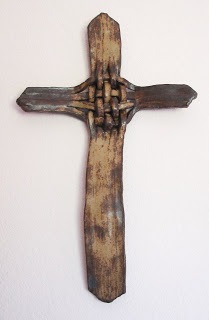Recently a student contacted me about how I weave clay. One thing I've learned about clay is: If it works for you, that's how you make it. But it might not be how other's make it. The basket above is up in my studio cabinet. I may get it out one of these days.
The clay cross above warped badly but it was too nice to toss. It's went to a cross collector in California years ago. When weaving clay I work with the clay fresh and wet. I cut the strips of clay from a slab and immediately place them on plastic and cover them with plastic. I only take out a few strips of clay at a time to work with them. I keep the remains strips covered. That's my first tip. Other makers may use leather hard clay, I don't know. I only know how I make my woven pieces.
Sometimes I use a form and drape the strips of clay over it which is how I made the basket above. Sometimes I use a form and drape the strips of clay inside it.
Here's a porcelain trivet from year's ago which broke after it's final firing. If you notice hairline cracks in the pieces of clay when you are weaving wipe them with a damp sponge to smooth them out. I don't use any slip between the pieces because I don't want to see the rough edges. You can use white vinegar between the pieces if they don't stick.
This piece I painted with acrylic paint after the final firing. It went to the shard pile. Why I'm not sure I'm rather missing it now.
This is a porcelain serving tray which I painstakingly brushed with colored slip in two colors and then glazed with a clear. There are lots of tutorials on youtube for weaving clay and a google search of weaving may bring you to other blog posts which are helpful. Start out by making trivets and flat pieces till you become familiar working with weaving your clay then branch out into more complicated pieces like baskets and bowls.
This is the first woven trivet I made in 2007 which I painstakingly glazed in two glazes and high fired. I put a hole in one corner so it could be hung on the wall. I think I might have sold it this past summer. That's another tip. If you don't sell something for years that doesn't mean it isn't a good piece or that it isn't sale able. It just hasn't find the right home. Thanks for reading and for all your comments.








I imagine you are far more kind about selling a piece that had a looonnng shelf life. In my booth we agreed with the customer how wonder and perfect it was, and high fived later. I love woven pieces.
ReplyDeleteHi Joanne, thanks, yes kind of the long shelf lives. Ha.
DeleteWoven pieces always intrigue me. And I love your first woven trivet. I would very happily have given it a home.
ReplyDeleteHi Elephant's Child, thanks, that trivet I also painstakingly brushed with two opposing colors and brought it home after firing and promptly dropped it on my kitchen floor. Ugh.
DeleteVery nice tutorial! Thanks for sharing the info!
ReplyDeleteHi Suzi, thanks, it's fun to make things that are woven and quite a challenge.
DeleteYour first trivet was a great start!
ReplyDeleteI get discouraged with pots that sit around, Jeff tells me to be patient... eventually they sell.
Hi Michele, thanks, yes that is so true, I notice pieces that didn't sell in Florida, sell here quite well, different markets are definitely worth trying.
DeleteI really love the woven pieces. I've never made pottery, but love to weave paper. I really admire the way you experiment with different techniques and in doing so, learn and come up with really interesting things. Good job!
ReplyDeleteHi Barbara, thanks, I was looking at woven baskets and woven fiber the other day and thinking about those again. Ha. Weaving can be addicting.
DeleteThose woven ceramic wares look very nice.
ReplyDeletesome great examples to inspire those wanting to try this technique. that rustic blue basket is terrific.
ReplyDeleteHi Gigi, thanks, something mesmerizing about woven pieces I have always liked baskets too.
ReplyDeleteFabulous work. :)
ReplyDelete